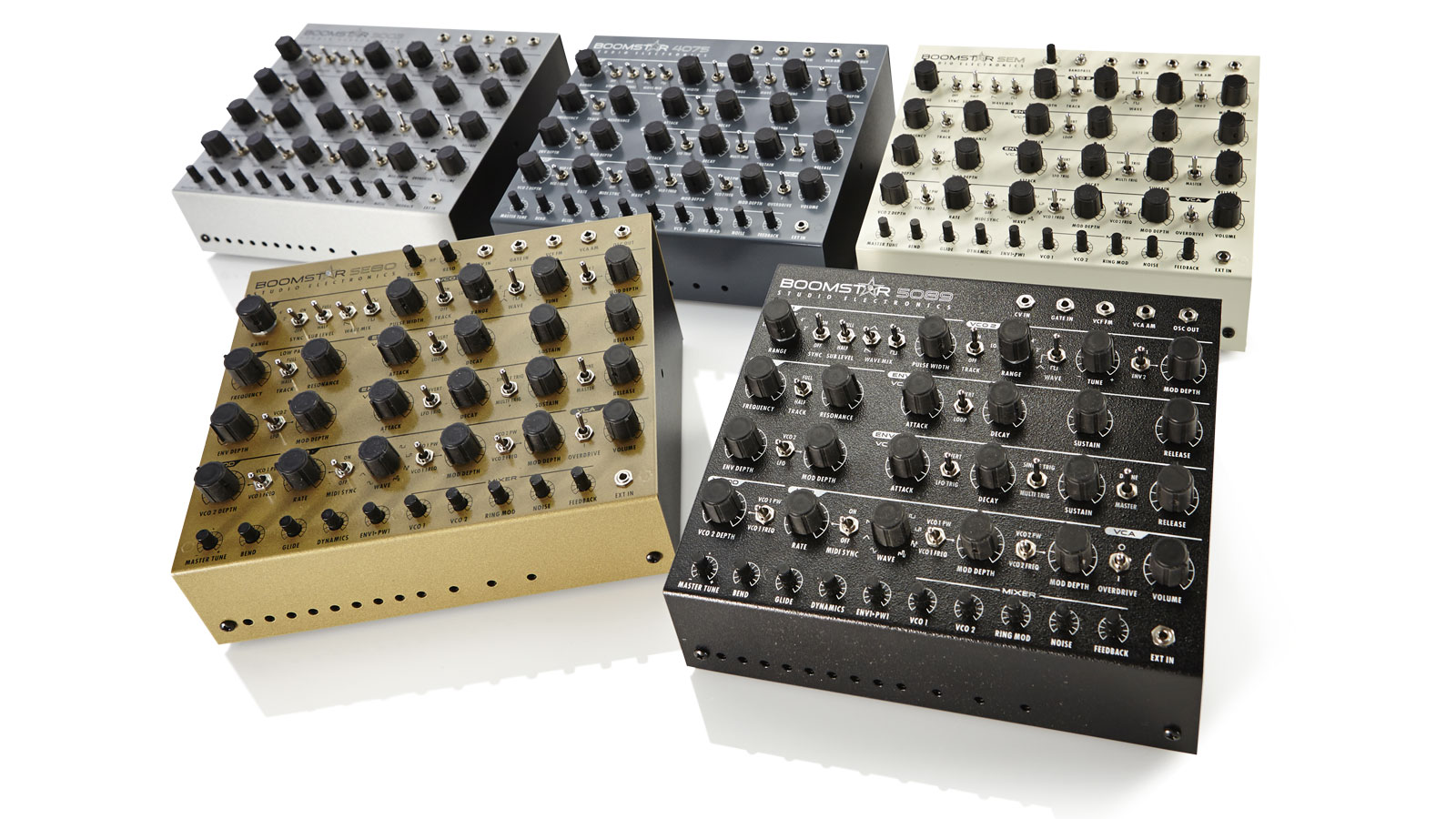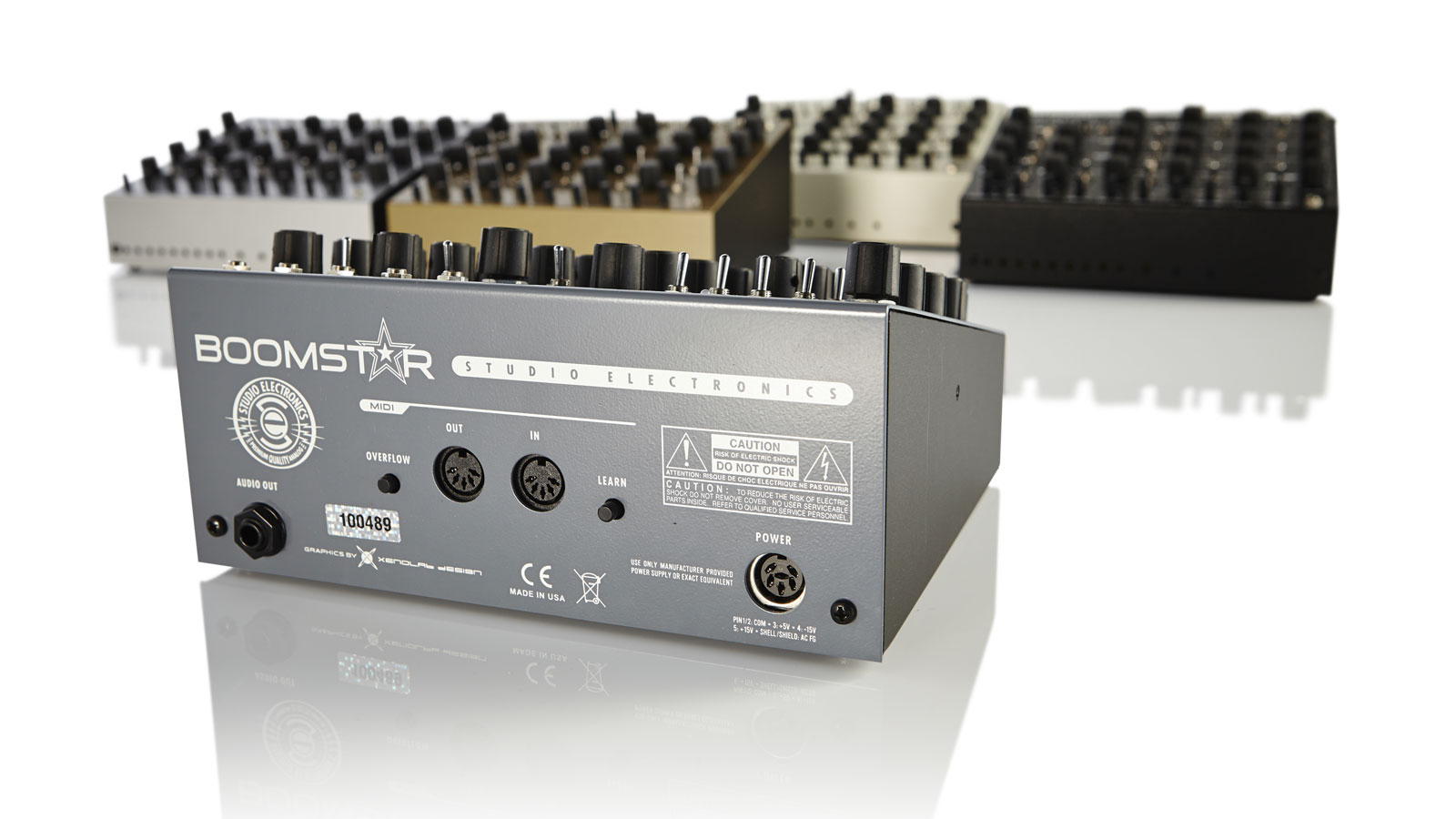MusicRadar Verdict
Any of these Boomstars would make a fine addition to any synthesist's armoury.
Pros
- +
The range of programmability is extensive. No menus, screens or sub-functions. The filters - all of them are great in their own way.
Cons
- -
Some of them exhibited a noticeable drift in tuning across the full frequency range.
MusicRadar's got your back

Studio Electronics Boomstars

Rear
Studio Electronics' new range synth modules take on a range of classic filters under the Boomstars moniker, including the 5089 - a Moog-style 24dB ladder; the ARP 2600-aping 4075; the SEM, based on an Oberheim 12dB SEM (full function with LP to HP mix control); the 3003 (its take on the Roland TB-303) and the SE80, which has been inspired by the Yamaha CS-80.
While the number of boutique instrument and processing companies seems to be increasing at an exponential rate, there are others that had faith in the power of analogue circuitry even at the height of the '80s digital boom-time. Studio Electronics initially gained recognition in the synth world for its rack-mountable Midimoog. In fact, it was predominantly a Moog product, as the synthesis section was taken from old Minimoog keyboards and placed inside a new box with SE-designed MIDI boards.
Inevitably, the supply of real Minimoogs for dissection dried-up - and Moog objected to the name - so SE explored the possibility of building its own synth circuitry. This resulted in the Midimini, with later iterations being 100% newly-minted synths, but with a definite old-school heritage.
This new-found enthusiasm for synth design resulted in the 'Analog Tone Chameleon' ATC-1 - a twin-VCO digitally-controlled monophonic analogue synth with a range of additional switchable filter cartridges (covering the Minimoog, Roland TB-303, ARP 2600 and Oberheim SEM designs).
Later came the SE-1, which once again referenced the Minimoog, but this time with both Moog and Oberheim-style filters.
Sonic boom
This interest in filter design points fairly and squarely at some of the design decisions made when coming up with the Boomstar range on review here.
"Each VCO has six switchable frequency ranges including a 'LO' option, whic causes the oscillator in question to revert to a sub-sonic LFO role"
All five Boomstar synths are effectively the same in specification-terms apart from the filter section. In broad terms we are looking at analogue, MIDI (or CV/Gate) controlled, twin-VCO, dual-envelope, single LFO synths laden with over 30 knobs, 18 switches - and without an LED or LCD display in sight. However, this doesn't say much about any possible design nuances or interesting features - of which there are many - so it pays to look a little deeper.
Want all the hottest music and gear news, reviews, deals, features and more, direct to your inbox? Sign up here.
According to SE, the two oscillators are based around the same design it has been using since its earlier Minimoog clone. However, the Boomstars have a design that utilises temperature compensating resistors on transistor array ICs to keep tuning stable (rather than discrete transistors). This similarity to the Moog is carried through to the VCA section as well.
Each VCO has six switchable frequency ranges including a 'LO' option (that causes the oscillator in question to revert to a sub-sonic LFO role) - more on this later. VCO 1 has four available wave shapes selected from two switches, meaning that triangle or sawtooth waves can be mixed with a sine or square.
Pulse Width (PW) of the square wave can be adjusted manually for this oscillator, though both oscillators can create the classic, fat and warm tones of PWM (Pulse Width Modulation) via the LFO modulation section.
VCO 1 also plays host to a third square wave sub-oscillator (one octave below the first). Unlike the main VCOs there's no independent volume control (but it can be switched from full to half volume - and off).
A Sync switch locks VCO 2's wave shape start point to that of VCO 1, essentially fixing its base frequency. When engaged, any outward changes to the frequency of VCO 2 will result in timbral differences rather than difference in perceived pitch. We'll put this into practice shortly.
VCO 2 has three independent wave shapes selectable from one switch - sine is dropped here. A Tune control allows this oscillator to be detuned in relation to VCO 1. The range extends from subtle detuning to greater than semi-tone spans.
Our only issue here was the sensitivity of the control around the centre mark, where finer control over the inter-oscillator beat frequency would have been much more welcome.
When testing the Boomstars we also noticed that some of them exhibited a noticeable drift in tuning across the full frequency range, with notes getting steadily sharper when moving through the octaves via the Range control.
Once warmed-up the issue was less marked, and this looks like it could be easily corrected with a little tweaking of the calibration pots accessible through small holes in the front panel. However, without a suitable screwdriver to hand, we resisted the urge to prod, poke and twist.
In place of manual PW adjustment, VCO 2 gets a dedicated modulation control that allows either of the two envelopes to control its frequency.
This works a treat when Sync is engaged allowing you to create classic metallic sync-sweeps with ease. Frequency tracking can be turned off for VCO 2 - good for when creating un-pitched effects or when using it as another LFO.
Resonant peak
Next on the panel we have the filter section. Although the filters vary between modules - and some offer additional controls elsewhere on the top panel - they all share similar functionality when it comes to the basics.
There are two dials for Frequency cutoff and Resonance, and three selectable keyboard tracking ranges (scaling cutoff as you move up the keyboard). The response, and ultimate sound, of both cutoff and resonance, varies massively - as you would expect - when moving between the different filter types of each unit.
For example, the 'SEM' exhibits little drop in level as resonance is increased, but does not proceed into self-oscillation at higher settings. However, the ARP-based 4075 drops in level quite early on in the resonance control's range and then starts to squeal at around 3 o'clock.
An envelope depth control determines the range over which the cutoff will be modulated by Envelope 1 (this is hardwired to the VCF). An additional Mod Depth control allows cutoff to be controlled by the main LFO or VCO 2. VCO 2 acts as an additional LFO when its Range is set to 'LO' and frequency tracking is disengaged, but allows for more gnarly modulation possibilities at audio-range settings.
Pushing the envelope
Both envelope generators on the Boomstars are of the four-stage ADSR variety. ENV 1 is hard-wired to filter cutoff, though as we've seen already, it can also be routed to control the pitch of OSC 2 - and there's a pot for using it to vary the pulse width of OSC 1's square wave. Both envelopes feature an Invert switch for reversing their polarity (so Attack, for example, starts off at maximum).
Loop mode is an interesting option, where the Attack and Decay portions of the envelope repeat. This turns ENV 1 into a form of customisable LFO. This is a much loved feature on this writer's Koma RH-301, and it is great to see it implemented here - the kind of small detail that makes these SE units more interesting than much of the competition.
The second envelope generator is routed to the VCA - to control the loudness contour - but again has some extra features up its sleeve. As well as being started with each note (with legato and retrigger modes), ENV 2 can be triggered by the LFO or opened continuously in Drone mode. We used this to audition all five units simultaneously, and with a result that ended up sounding like a '70s Italian horror movie - brilliant!
How low can you go
The LFO on the Boomstars is software generated, which makes for a wide range of possible wave shapes and full MIDI clock sync. The two Mod Depth controls (one for each oscillator) can be routed to modulate the Pulse Width or Frequency of the VCOs.
"The SE80 is capable of the widest range of tones, from weird and vocal-like to positively nasty"
There's another neat modulation possibility found in the X MOD section, where it is possible to use the frequency of VCO 2 to modulate the Pulse Width or Frequency of VCO 2 - great for clangorous FM tones and unusual textures.
The VCA itself has one important control, Overdrive, which does exactly what you expect, and allows you to push the synth into more saturated territory. It works a treat with the 3003 when looking for that 'acidic' drive.
The synths' remaining sound-shaping controls are accessed via a row of small knobs at the bottom of the front panel, with MIDI and audio connections on the rear. CV/Gate connectivity is included in the form of five 3.5mm jacks, although it would have been good to have external access to some of the LFO parameters and the VCOs independently. The audio input is a nice bonus.
In terms of MIDI, SE keeps things very simple, but this does mean that CC control of parameters is sparse, though you can control volume, vibrato (via the mod wheel) and filter cutoff (from aftertouch).
Conclusion
There are a few aspects of the design that could be improved - external PSU, no power switch, lack of clear knob markings or accurate pot control - but for the most part these are aesthetic or ergonomic rather than sonic. The sound is hard to fault.
So now for the big question - if you could choose only one, which would it be? Our gut instinct would be to go for the Yamaha CS-80 flavoured SE80, if only because its filter configuration is relatively uncommon.
It is also capable of a potentially wider range of tones in comparison to the other boxes. The low and high-pass filters in series are capable of generating weird vocal-like tones and, when resonance is pushed up and overdrive with feedback is engaged, it sounds positively nasty.
At the same time it is capable of very gentle leads and sweeps. For an all-round Moog alternative, the 4075 is also a good bet. This isn't to say that the others are bad - they're all great.
All told, these Studio Electronics boxes offer enough modulation and processing options to give many other current analogues a run for their money and should be on your 'must-try' list if you're considering monophonic analogues new or old.